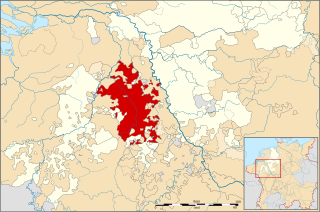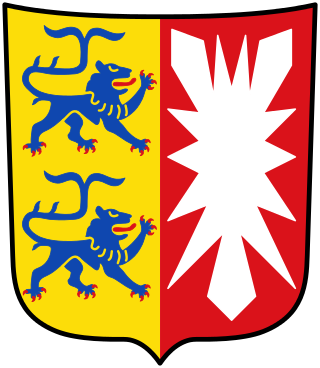
The Duchy of Guelders is a historical duchy, previously county, of the Holy Roman Empire, located in the Low Countries.
The district of Aachen is a district in the west of North Rhine-Westphalia, Germany. Neighboring districts are Heinsberg, Düren, Euskirchen, and also the Netherlands province of Limburg and the Belgian province of Liège. Its administrative body is the Städteregionsparlament, headed by the Städteregionspräsident or "region president".
The Rhein-Erft-Kreis is a district in the west of North Rhine-Westphalia, Germany. Neighboring districts are Neuss, district-free Cologne, Rhein-Sieg, Euskirchen, Düren.

Berg was a state—originally a county, later a duchy—in the Rhineland of Germany. Its capital was Düsseldorf. It existed as a distinct political entity from the early 12th to the 19th centuries.

The County of Mark was a county and state of the Holy Roman Empire in the Lower Rhenish–Westphalian Circle. It lay on both sides of the Ruhr River along the Volme and Lenne rivers.
Kleve or Kreis Kleve is a Kreis in the Lower Rhine region of northwestern North Rhine-Westphalia, Germany. Neighbouring districts are Borken, Wesel, and Viersen in Germany, and the Dutch provinces of Limburg and Gelderland.

Neuss is a Kreis (district) in the west of North Rhine-Westphalia, Germany. Nearby are the urban districts Mönchengladbach, Krefeld, Duisburg, Düsseldorf, Cologne, the districts Rhein-Erft-Kreis, Düren, Heinsberg and the district Viersen.
Viersen is a Kreis (district) in the west of North Rhine-Westphalia, Germany. Neighboring districts are Cleves, Wesel, district-free Krefeld, Neuss, district-free Mönchengladbach, Heinsberg and the Dutch province of Limburg.

The Duchy of Jülich comprised a state within the Holy Roman Empire from the 11th to the 18th centuries. The duchy lay west of the Rhine river and was bordered by the Electorate of Cologne to the east and the Duchy of Limburg to the west. It had territories on both sides of the river Rur, around its capital Jülich – the former Roman Iuliacum – in the lower Rhineland. The duchy amalgamated with the County of Berg beyond the Rhine in 1423, and from then on also became known as Jülich-Berg. Later it became part of the United Duchies of Jülich-Cleves-Berg.

Goch is a town in the district of Kleve, in North Rhine-Westphalia, Germany. It is situated close to the border with the Siebengewald in Netherlands, approx. 12 km (7 mi) south of Kleve, and 27 km (17 mi) southeast of Nijmegen.

Übach-Palenberg is a town in the Heinsberg district of North Rhine-Westphalia, Germany. It was formed by the merger of two villages, Palenberg and Übach.

Erkelenz is a town in the Rhineland in western Germany that lies 15 kilometres southwest of Mönchengladbach on the northern edge of the Cologne Lowland, halfway between the Lower Rhine region and the Lower Meuse. It is a medium-sized town and the largest in the district of Heinsberg in North Rhine-Westphalia.

Geldern is a city in the federal German state of North Rhine-Westphalia. It is part of the district of Kleve, which is part of the Düsseldorf administrative region.

Straelen is a municipality in the district of Cleves, in North Rhine-Westphalia, Germany. It is located near the border with the Netherlands, approx. 10 km north-east of Venlo.

The coat of arms of the German state of Schleswig-Holstein is vertically divided: in the heraldically right field, i.e. left as seen by the viewer, two blue lions are depicted on a golden background, facing the other half. The lions of Schleswig were taken from the coat of arms of Denmark. The heraldically left side is red with the silver nettle leaf of Holstein, an ancient symbol which had been in use with the Counts of Schauenburg and Holstein.

William was Duke of Guelders, as William I, from 1377 and Duke of Jülich, as William III, from 1393. William was known for his military activities, participating in the Prussian crusade five times and battling with neighbors in France and Brabant throughout his rule. His allies included Holy Roman Emperors, Charles IV and Wenceslaus, Richard II of England, and Conrad Zöllner von Rothenstein, the Grand Master of the Teutonic Knights. During his reign the duchies of Guelders and Jülich were temporarily unified.

The Royal Order of Saint Hubert, or sometimes is a Roman Catholic dynastic order of knighthood founded in 1444 or 1445 by Gerhard VII, Duke of Jülich-Berg. He sought to commemorate his victory over the House of Egmond at the Battle of Linnich on 3 November, which is Saint Hubert's day.

Ruprecht of the Palatinate was the Archbishop and Prince Elector of Cologne from 1463 to 1480.
Marie of Guelders was one of two pretenders to the title of Duchess of Guelders and Countess of Zutphen on behalf of her son during the War of the Guelderian Succession from 1371 to 1379.

















